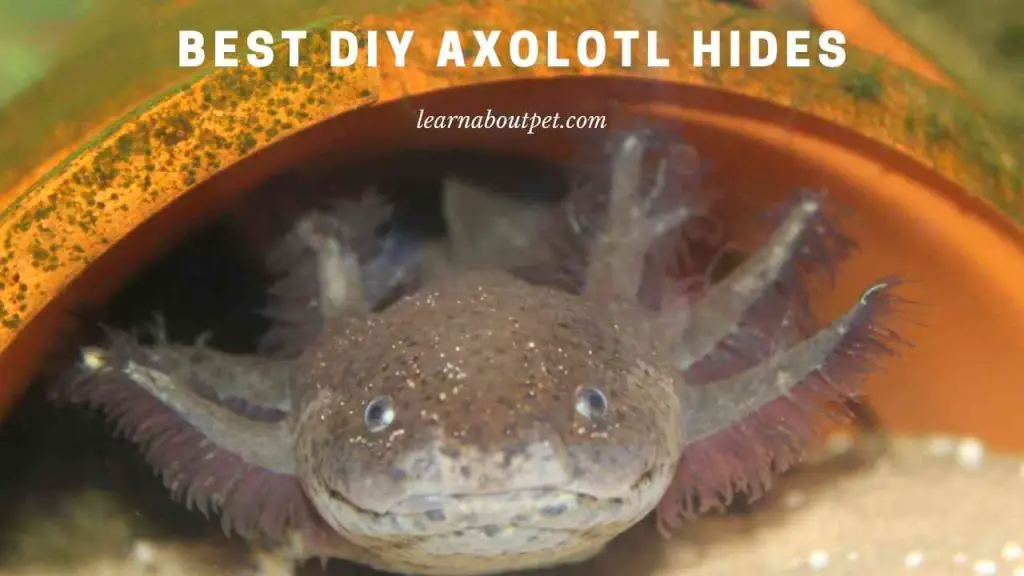Axolotl owners have the option of either buying readymade axolotl hides or using homemade (DIY) axolotl hides. In this article, you will find information on the homemade axolotl hideouts – including what you can use to make them, how to go about making them, their pros and their cons.
DIY axolotl hides can be made using plastic containers, PVC pipes, coconut shells, stones or terracotta pots, among other materials. The hides need to be big enough for the axolotls to fully go inside. They also need to have no sharp or rough edges that can hurt the axolotls’ sensitive skins.

These hides provide safe spaces for the axolotls to shelter from high intensity light. They also provide the axolotls with a greater sense of security, and they can improve the aesthetic appeal of the axolotl tanks.
Do Axolotls Need Hiding Spots?
Axolotls do need hiding spots. This is because they are sensitive to high intensity light. Therefore they need somewhere they can hide from such light.
If you keep an axolotl in a tank that has no hides, you may end up stressing it greatly.
Besides giving the axolotl somewhere to hide from high intensity light, the hides serve other purposes.
For one, they also give the axolotl a better sense of security. An axolotl living in a tank that has no hides will most likely not have a full sense of security.
Further, the axolotl hides can greatly enhance the appearance of the axolotl tank.
The general guideline is to ensure that there are at least a couple of hides for each axolotl.
What Hides Are Good For Axolotls?
The best axolotl hides are those that meet a certain criteria.
Firstly, they should provide genuine shelter from high intensity light. So they should be somewhat dark inside, like caves.
Secondly, they should be big enough to properly accommodate the axolotls.
Thirdly, the hides should have no sharp/rough edges that can scrape/hurt the axolotl’s sensitive skin.
Fourthly, the hides should allow for easy entry and exit of the axolotl.
Fifthly, the hides should be easy to clean.
Sixthly, the hides should be made from materials that are not potentially toxic to the axolotls.
And seventhly, there are those who may argue that the hides should also be aesthetically appealing.
In practical terms, there are DIY axolotl hides. Then there are readymade axolotl hides that one can buy from vendors. Online and elsewhere, you will usually find many vendors offering all sorts of axolotl hides for sale.
DIY axolotl hides can be particularly attractive if you prefer DIY axolotl decor.
Of course, if you opt for the homemade axolotl hides, you need to ensure that they meet the criteria outlined above.
How Do You Make DIY Axolotl Hides?
Firstly, you need to make a decision on what materials you are to use in making the axolotl hides.
Options here include PVC pipes, stones (joined together using aquarium silicone), plastic containers, ceramics and organic materials such as coconut shells.
Therefore you can end up with a PVC pipe axolotl hide, a stone axolotl hide, plastic container axolotl hides (like, say, a colander axolotl hide), a ceramic axolotl hide and so on.
Once you settle on the material you will be using to make the axolotl hide, you need to start designing it.
Online, there are many places you can find DIY axolotl hiding places / ideas for axolotl tank hides. For instance, most of the ideas for axolotl hides Reddit contributors recommend are quite sound.
You may also look for Etsy axolotl hide ideas or for Pinterest axolotl hide ideas.

By the way, some people may refer to the axolotl hide as an ‘axolotl cave’. Therefore, to broaden your search, you may use terms such as ‘axolotl cave ideas’, ‘axolotl cave hide ideas’ and so on.
The key question to ask yourself here is: how do I make my axolotl hide using the materials that are easily available to me?
Or you may simply ask yourself, what can I put in the tank as a hide for axolotls (and how do I need to modify it, to make it fit for the purpose)?
Another question you can ask yourself here is: how do you make an axolotl cave using easily available materials?
Ultimately, once you get workable axolotl hide ideas, the next step is to implement these ideas, in order to end up with usable axolotl hides.
Implementing The Axolotl Hide Ideas
Suppose, for instance, you opt to make DIY axolotl hides using PVC pipes. The first step here would be that of cutting the PVC pipe to a suitable size.
If you are making hides for adult axolotl, you need to know how big the axolotl is. Then ensure that the dimensions you work with give rise to proper, fully grown axolotl hides.
After cutting the PVC pipe to a suitable size, you sand its edges, to ensure that not part of them is sharp enough to scrape the axolotl’s skin.
Then you may need to glue stones to the PVC pipe. This will help to prevent the axolotl hide you make from floating. It will also help in darkening the area inside the hide, so that it offers the axolotl genuine protection from high intensity light.
After doing this, all that remains is to attach the hide to the bottom of your axolotl tank.
This may also be largely the approach to use, if you are trying to craft a DIY axolotl hide out of a plastic container or terracotta pot.
What if you are using stones to make the axolotl hide? Here, the first step will be to thoroughly clean the stones. Then smoothen up, so that there are no rough edges that can scrape the axolotl.
Thereafter, you place the stones on top of each other, using aquarium silicone as ‘cement’, to end up with a cave-like structure…
If you are using a coconut shell, you first clean it thoroughly, then cut it into a suitable size. Then you create an opening through which the axie would be going in and out. Thereafter you sand the edges, to ensure that they are not sharp/rough enough to hurt the axolotl.
DIY Axolotl Hides Pros
Firstly, we find that the DIY hides give you greater freedom for customization.
Secondly, the DIY hides may help you save money. That is because you can craft them out of easily available materials.
Thirdly, the process of making the DIY hides may give you a chance to exercise your creative faculties.
DIY Axolotl Hides Cons
Firstly, the process of making the DIY hides may end up taking too much of your time.
Secondly, it may be hard for you to come up with DIY hides that are entirely safe for the axolotl. Some of the materials you use may have toxins. Or you may not be able to sand out edges to a point where they can’t hurt the axolotl’s skin.
What Are The Alternatives To DIY Axolotl Hides?
There are two key alternatives.
The first one is where you opt to buy a readymade axolotl hide. There are many vendors who sell these sorts of supplies online.
If, for instance, you ask any fellow axolotl owner, where do you buy your hides for axolotls, they are likely to be more than happy to point you in the right direction.
The other alternative is to get an experienced craftsman to make the axolotl hides for you. So you just explain to the craftsman what you have in mind, and he proceeds to make it for you (with the benefit of better craftsmanship and better equipment).
Final Verdict – DIY Axolotl Hides
It is possible to fashion axolotl hides out of materials like PVC pipes, coconut shells, stones, terracotta pots, plastic containers and so on.
These hides serve the purpose of giving the axolotl somewhere to shelter from intense light. They can also give the axolotl a greater sense of security, while also improving the overall appearance of the axolotl tank.

The most important thing is to ensure that the axolotl hides one makes are of adequate size, they provide real protection from intense light, and they are safe for the axolotl.
As a pet lover, make sure to learn about pet more and give your pet axolotl a good and comfortable life!

Welcome to Learn About Pet. My name is Rajkumar Ravichandran and I love all pets, travel, and amazing food. I write about my passion and personal experience caring for multiple pets in this blog! ❤️
Post Disclaimer
DISCLAIMER: THIS BLOG OR WEBSITE, "Learn About Pet", DOES NOT PROVIDE YOU WITH MEDICAL ADVICE AND IS NOT A SUBSTITUTE FOR MEDICAL ADVICE. ALWAYS GET IN TOUCH WITH YOUR PERSONAL VETERINARIAN AND USE INFORMATION HERE AS GENERAL ADVICE.
The information, including but not limited to, text, graphics, images and other material contained on this website are for informational purposes only. No material on this site is intended to be a substitute for professional veterinary advice, food recommendation, diagnosis, or treatment. Always seek the advice of your veterinarian or other qualified health care provider with any questions you may have regarding a medical condition or for pet food related questions.







